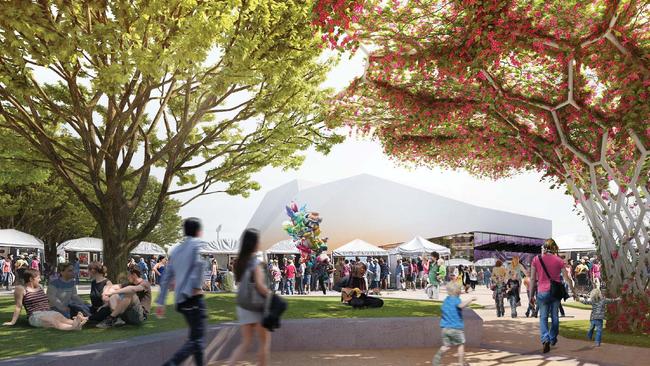Festival Plaza artwork by Otto Hajek to be removed for riverbank development
IT’S an Adelaide icon that “people love and a lot more people love to hate” but this week, all South Australians will farewell Otto Hajek’s garden of sloping concrete pillars at the Festival Plaza.
SA News
Don't miss out on the headlines from SA News. Followed categories will be added to My News.
- Major milestone for $900 million riverbank development
- Plan for art gallery in Festival Plaza revamp
- Festival Plaza development: Green light for $610m revamp
IT’S an Adelaide icon that “people love and a lot more people love to hate” but this week, all South Australians will farewell Otto Hajek’s garden of sloping concrete pillars.
Contractors on Tuesday will begin removing the many artworks that adorn Festival Plaza as the State Government prepares to demolish the carpark below it.
In May, the Government signed two formal agreements with private investors for the site, which Premier Jay Weatherill said would allow the $900 million revamp to proceed — including the plaza upgrade, high-rise office tower and casino redevelopment.
The Czech-born artist’s sprawling installation, between the Festival Centre and Parliament House, was built into the plaza surface itself, which is riddled with “concrete cancer”.
A Government spokeswoman said artwork removal would begin Tuesday.

“Tenders for early works (on the plaza site) are expected to be awarded in late August with preliminary on-site works expected to commence in early September,” the spokeswoman said.
“Restrictions on access to the northern end of the Adelaide Railway Station is not expected until later in the year.”
The Government has set aside almost $1 million to demolish, remove and in some cases store and reinstall all of the plaza art.
Bert Flugelman’s Tetrahedra and the Kaurna Reconciliation Sculpture have been planned to feature in the redeveloped plaza.
During public consultation on the plaza redevelopment’s design, the Government found there was support for retaining the giant Hajek sculpture and the artist’s estate was also keen to see it saved.
Arts SA executive director Peter Louca said it was a significant piece of art, the largest Hajek ever produced, and had an important place in SA’s history. But he admitted it had certainly “divided opinion at the time and divides opinion now”.

“I think it’s safe to say the Hajek sculpture has been divisive through its history. There are people who love them and a lot more people who love to hate them,” he said.
Mr Louca said the agency had been working with Hajek’s estate for some months to preserve a “tribute” to the artist for the new plaza.
It could include salvaging of one of the rhomboid concrete pillars but the options were still being discussed.
“We have engineering reports showing we can’t preserve that work ... but it depends on what the builders can keep. We don’t know what condition they’re in so we might have to remake one,” Mr Louca said.
“We’ve done a 3D laser scan, taken high-definition photographs and commissioned History SA to record the development of the work.
“Potentially we could do a 3D laser print, a reproduction of it at a different scale. Or
there’s glass blocks which you can etch.
“But when Otto Hajek was alive he made very clear if we had to interfere with or remove the art his preference was to remove it all so what we’d be looking to do is preserving something as a tribute.”
What is the sculpture?

■ Designed by Czech-born sculptor Otto Hajek, left. The artwork’s proper title is City Sign.
■ It was commissioned in 1973 as part of the original Adelaide Festival Centre and opened in 1977. Then premier Don Dunstan described the sculpture as “one of the most exciting outdoor art projects in the world’’.
■ As early as 1978, however, the Civic Trust described the work as “boring and a failure” and “a visual outrage”.
■ It was designed to be used as a walk-in sculpture the public could use as a meeting place, for entertainment and enjoyment. However, it is often decried for its lack of shade, harsh concrete feel and “licorice allsorts” appearance.
■ At the time of its construction, Hajek, who died in 2005, was unofficially reported to have been paid $100,000 but was said to have come to an “agreement” with the Festival Centre Trust over the cost because he was keen to have his work represented in Australia. His public sculptures are located almost exclusively in his later homeland of Germany (with the exception of works held in Adelaide, Moscow, and Medellín, Colombia).



